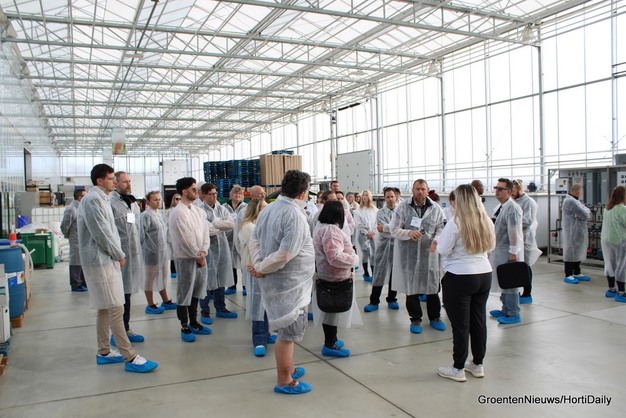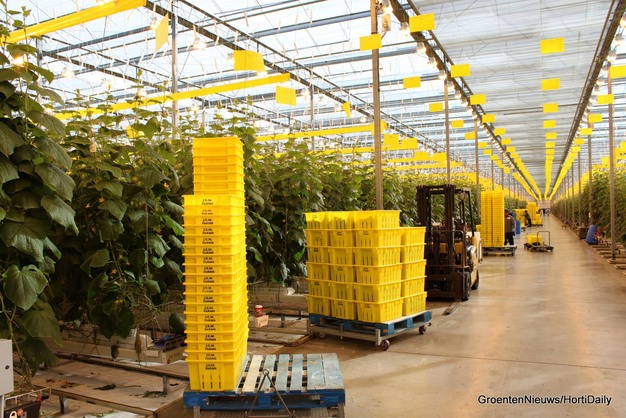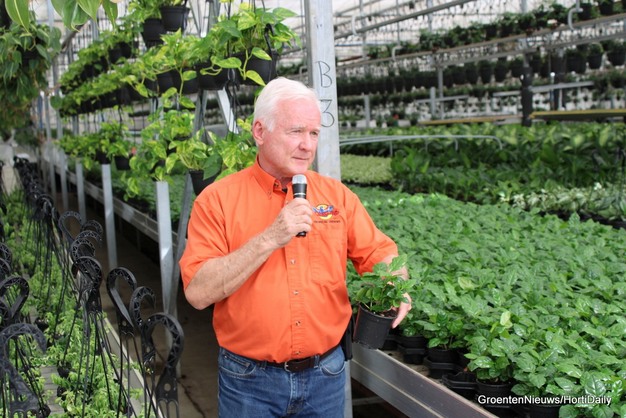"What is your stem density? Could you tell us more about pollination? How do those by-laws work?" These are just some of the questions that growers on the bus tour, held the day before the Canadian Greenhouse Conference, are being bombarded with. The questions reveal a mix of visitors—some are just getting acquainted with greenhouse horticulture, while others are experienced growers, digging into the finer details.
In both cases, participants get a unique opportunity to visit a tomato greenhouse, a cucumber greenhouse, pot plant production and sales, and a greenhouse plant propagation facility. Ridge Farms, JEM Farms/Horteca, Colasanti's Tropical Gardens, and Ontario Plants Propagation open their doors the day before the trade show kicks off.
Even while traveling from one location to another, there's plenty to see. Across the greenhouse area between Kingsville and Leamington, construction is underway at various sites. New, large greenhouses are being built, adding to the region's already impressive scale. This doesn't go unnoticed by growers from other Canadian regions, where greenhouses tend to be smaller. "How many acres do you have?" one grower asks a colleague. "Less than one acre," comes the reply. And how many acres does the questioner have? Four."

Visiting Ridge Farms. See the whole photo report here.
Tomatoes without artificial lighting
The greenhouses the group gets to tour are mostly new, if not brand new, with one exception. The greenhouse at Ridge Farms was built in 2021. Here, disease-resistant tomatoes, along with various trial varieties from the breeding company Bayer, are grown without artificial lighting. On average, it takes about four to five days for the tomatoes to reach store shelves after harvest, explains grower and today's guide, Sydneigh Wilson. She enthusiastically shares details about the available technologies, from hygiene locks to water disinfection, and from heating systems to lighting.
On the topic of lighting, she has a clear stance. While it allows for year-round cultivation, it also presents challenges. "With lighting, you create a tropical climate that pest insects thrive in." This leaves the tomato farm undecided on whether or not to use it. Additionally, there's competition from Mexico, where they grow tomatoes without artificial lighting during the winter, competing with local Canadian products. Still, when you look at the supermarkets in the region, they take great pride in their homegrown produce—nearly every tomato or cucumber is marked with a little Canadian flag.

Inside look at JEM Farms. View the entire photo shoot here.
Better for the neighbors
At JEM Farms, the HPS lighting in both the cucumber and mini-cucumber greenhouses is fully on this Tuesday morning. A little later, the group enters another greenhouse, which serves as a demo center. Here, they are comparing full LED lighting with a hybrid system. The decision has been made to use lighting, although they are still figuring out the best approach for the future. Meanwhile, they are heavily investing in systems like Airmix to keep the windows closed more often, which is great for energy savings but also benefits the neighbors, explains head grower Blake. The local by-laws require growers in the area to pay closer attention to light emissions.
"Oh, you're from the Netherlands," Blake says with a smile, as we pause with a fellow Canadian grower near a machine in the shed. The machine is essentially a shredder for crop rotation. He chuckles, "In the Netherlands, they have special machines for that, I know." JEM Farms built their own machine, borrowing technology from a machine designed for shredding corn.

Terry Colasanti. See the whole photo report here.
Goats
The contrast between the two greenhouses full of vegetables and Colasanti's greenhouse is striking. Instead of a tall, modern greenhouse, Colasanti's is a family business where the fourth generation knows exactly how to make plants appealing to consumers. They grow their own plants at several locations, selling them both wholesale and directly to consumers at their retail site.
The top seller is the Venus flytrap (Dionaea muscipula), the only plant in the greenhouse that requires artificial lighting. You'll find all kinds of lights throughout the business, especially in the retail section, which is filled with flashing arcade machines. Visitors can also enjoy mini-golf and see tropical animals—efforts to make Colasanti's a destination for a wide audience.
Grower Terry shares how they once brought alligators into the greenhouse to attract visitors, but it turned out that the goats became the most popular attraction. In the future, the focus will shift away from exotic animals, while the selection of plants, which are often exotic, will continue to expand—along with the humid climate, at least for the plants!

Team photo bus tour at construction site at Ontario Plants Propagation in Glencoe. See the entire photo report here.
Mega high-tech
After the break, the group travels to Glencoe. The bus first drives past a construction site before finding the entrance. Upon arrival, they are welcomed with barbecue snacks and music. That morning, the official opening ceremony had just taken place. The first 13 acres are nearly complete, showcasing an impressive, mega high-tech complex. During the tour, workers are still on-site, including hanging HPS lighting.
The goal of the new propagation facility, which is under Dutch leadership, is to grow plants on a large scale in a highly hygienic environment with fewer workers. A central element of this plan is the logistics system that will eventually move over 5,000 containers, and when the full 44 acres are operational, it will handle more than 20,000 containers, explains Director of Operations Theun Peters.
The scale is impressive, and this holds for all the companies visited during the bus tour. Visitors unfamiliar with high-tech greenhouse horticulture were wide-eyed with wonder, while those who know the sector better were amazed by the extent of automation implemented in the greenhouse of Ontario Plants Propagation in Glencoe. Take a look at the photos, and take a tour from the start at Ridge Farms to the end at Ontario Plants Propagation.
